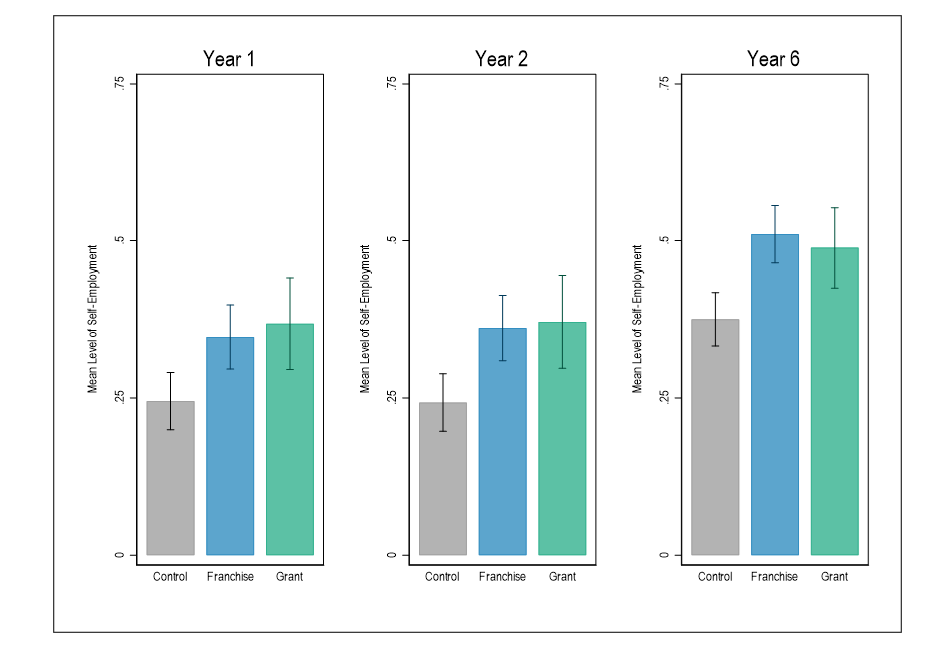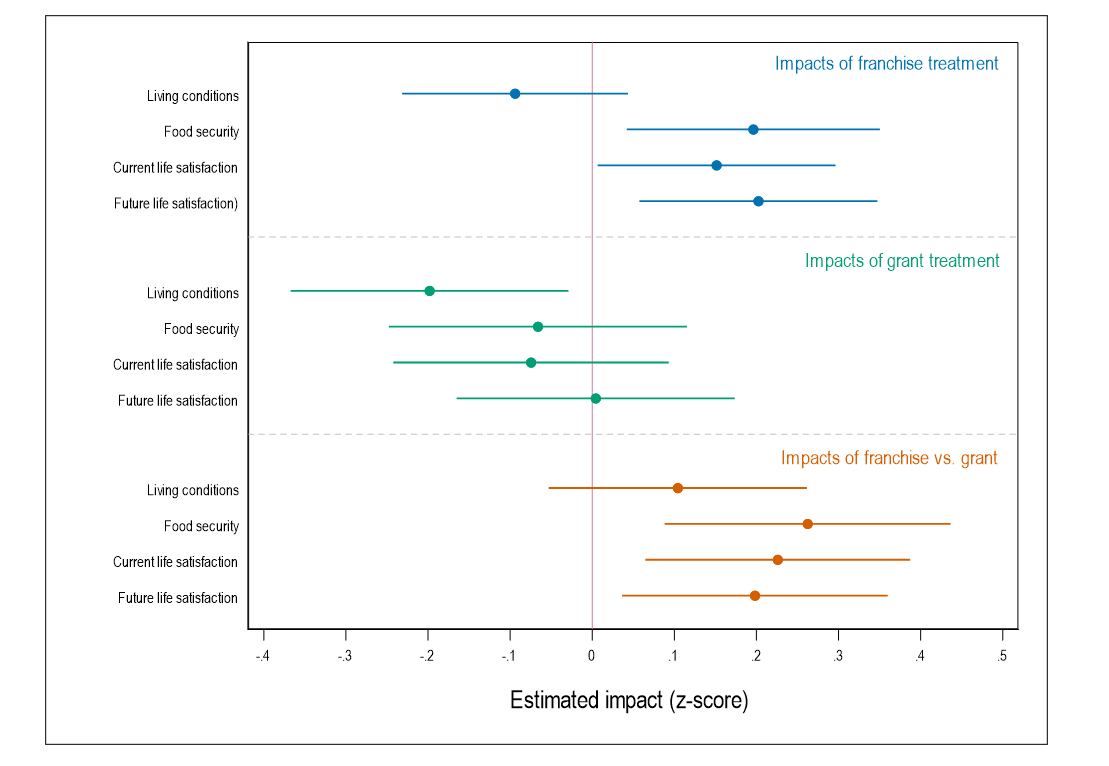
Cash grants and a multifaceted entrepreneurship programme both had temporary impacts on young women’s income in Nairobi, Kenya, but only the more holistic approach led to long-term improvements in wellbeing
Millions of African youth are looking for work. Africa’s growing population and its small formal sector contribute to persistent youth underemployment, and for many young people, it takes years to find a reliable means of generating an income and supporting a family (Filmer and Fox 2014).
Policymakers have tried a broad range of approaches to addressing the problem of youth underemployment. In contexts like urban Kenya, where the formal sector is small relative to the pool of unemployed workers, these approaches typically centre around entrepreneurship promotion. To the extent that potential entrepreneurs can’t afford the up-front costs of starting a business (i.e. lumpy capital goods) because of credit and liquidity constraints, a simple cash grant or low-interest loan might be enough to help young people start microenterprises and escape a poverty trap. However, many studies of cash grants suggest that on their own, they are rarely enough to shift poor women into productive self-employed work. At the other extreme, multifaceted programmes can sometimes help young women increase their involvement in income-generating activities while also empowering them (Bandiera et al. 2020).
To better understand how these different labour market interventions alter young women’s occupational trajectories, we conducted a randomised evaluation of a multifaceted entrepreneurship programme implemented by a large international NGO. The programme combined a number of elements common to youth labour market interventions: business and life skills training, vocational education, grants of physical capital, and ongoing mentoring. One unique aspect of the intervention was an explicit focus on specific sectors and business models, helping young women to launch franchise businesses loosely linked to existing Kenyan brands.
Participants chose to either start a small-scale salon or to operate a mobile cart selling prepared foods. Our three-arm randomised trial compared the multifaceted programme to both a pure control group and an unrestricted cash grant. Eligible applicants to the multifaceted NGO programme – all of whom were young women aged 18-20 from poor neighborhoods in Nairobi – were assigned to one of the three treatment arms. Our design allows us to test whether cash alone is enough to help potential microentrepreneurs escape a poverty trap, and to compare the impacts of cash to the effects of a more holistic programme intended to overcome a number of different barriers simultaneously. Three rounds of follow-up data – collected one, two, and six years after treatment – allow us to unpack the impacts of the two interventions on young women’s occupation trajectories and other life outcomes.
Impacts on occupational trajectories
Our first set of results relates to the labour market outcomes. We find that the multifaceted programme and the unrestricted cash grant had broadly similar impacts on occupational trajectories. Both treatments increased self-employment by about 10 percentage points, and these impacts did not diminish over time. As the figure below illustrates, only one in four women in the control group was self-employed two years after treatment, so the observed treatment effects represent proportionately large increases in the prevalence of microentrepreneurship. The increase in self-employment came from both a modest decrease in the likelihood of doing paid work (either formal wage employment or casual paid labour), particularly in Year 1, and a modest increase in the overall likelihood of being involved in an income-generating activity.
Figure 1: Impacts on occupation trajectories

Though impacts on self-employment are persistent, impacts on labour income appear temporary. In Year 1, both treatments had positive and statistically significant effects on income: the multifaceted programme increased labour income by about a third while the cash grant increased labour income by about 60%. However, these impacts on income disappeared by the second year after treatment – as the control group entered the labour force and gained experience – and impacts remained absent in Year 6. Thus, both treatments shifted women into self-employment, and women stayed there; but neither treatment increased labour income in the long run.
Impacts on wellbeing
In our Year 6 follow-up survey, we collected data on several measures of individual wellbeing beyond labour income: living conditions, food security, and subjective life satisfaction. We chose to focus on individual-level measures, rather than household-level measures like consumption per capita, because many of our young respondents were still not heads of their own households (or spouses of heads of households). The figure below summarises the impacts of treatment on these measures of relatively long-term wellbeing, and compares the impact of the multifaceted programme to the impact of the cash grant.
Figure 2: Impacts on wellbeing

Though the two interventions had comparable impacts on young women’s labour market trajectories, we find strikingly different patterns of impacts on wellbeing-related outcomes: the multifaceted programme had substantial positive impacts on both objective wellbeing (food security) and subjective wellbeing (life satisfaction), while the cash grant alone did not have such positive impacts.
Though it may seem puzzling that two programmes that had similar impacts on labour market outcomes had different impacts on wellbeing, there are several potential explanations – all related to the fact that the multifaceted programme may have impacted women’s self-confidence, their sense of identity, and their social networks in ways that cash grants did not. Women in the multifaceted programme work in different sectors than those who received cash grants – specifically, they are more likely to work in the salon sector – and they also work marginally fewer hours to earn similar levels of income. In addition, relative to the grant treatment, the multifaceted programme improved women’s assessments of their own entrepreneurial ability and their self-esteem.
Conclusions and policy implications
Our finding—that impacts on wellbeing may exist even when impacts on income are no longer evident—resonates with other recent work, including studies of Moving to Opportunity in the United States (Ludwig et al. 2012). The ability to compare two interventions in the same setting with the same population is also helpful in understanding the dynamics of these interventions. Our work is not the first to navigate external validity issues in this way (cf. McIntosh and Zeitlin 2022), but for policymakers and researchers, the convincing impacts of GiveDirectly raise the question of whether a simpler intervention would do just as well as a more complex one (Haushofer and Shapiro 2016). As for the specific case of urban Kenya, the young women in our study do not show signs of being in a poverty trap that either a few hundred dollars or this multifaceted programme could extract them from. The short-term income increase was surely helpful, but in spite of participants’ temporary income rise, their incomes reverted to the same levels as seen in the comparison group within two years. Nevertheless, these programmes can change professional trajectories, and in the case of the bundled programme, leave women better off (in non-income terms) six years later.
References
Bandiera, O, N Buehren, R Burgess, M Goldstein, S Gulesci, I Rasul, and M Sulaiman (2020), "Women's empowerment in action: evidence from a randomized control trial in Africa", American Economic Journal: Applied Economics, 12(1): 210-259.
Filmer, D and L Fox (2014), Youth Employment in Sub-Saharan Africa: Overview, Washington, DC: World Bank.
Haushofer, J and J Shapiro (2016), "The Short-Term Impact of Unconditional Cash Transfers to the Poor: Experimental Evidence from Kenya", Quarterly Journal of Economics, 131(4): 1973-2042.
Ludwig, J, G J Duncan, L A Gennetian, L F Katz, R C Kessler, J R Kling, and L Sanbonmatsu (2012), "Neighborhood Effects on the Long-Term Well-Being of Low-Income Adults", Science, 337(6101): 1505-1510.
McIntosh, C and A Zeitlin (2022), "Using Household Grants to Benchmark the Cost Effectiveness of a USAID Workforce Readiness Program", Journal of Development Economics, 157: 102875.




